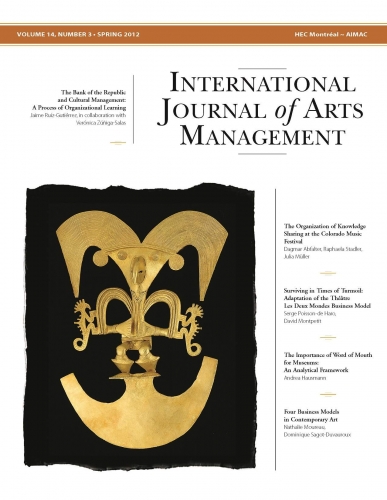The Importance of Word of Mouth for Museums: An Analytical Framework
Produit: Article
21,00 $ CA
Andrea Hausmann
Andrea Hausmann is associate professor of arts management and head of the Cultural Management and Cultural Tourism master’s program at European University Viadrina Frankfurt (Oder), Germany.
ABSTRACT
For some time now, the literature on general marketing has been discussing word of mouth (WOM) as a valuable instrument for creating awareness of products, disseminating information and winning new customers. In this era of social media, WOM is also gaining effectiveness due to the fact that a single recommendation on Facebook or Twitter reaches an unlimited number of recipients. However, there has been virtually no research on the field of WOM in arts marketing in general and museum marketing in particular, even though visitor surveys have repeatedly shown that personal referrals are one of the main reasons for making a museum visit. The contribution of this article is threefold. First, it opens up a new area of research in museum marketing with a comprehensive and well-founded theoretical analysis of WOM in the era of social media. Second, to foster empirical research on the topic of WOM in museum marketing – where there have been no studies so far – it suggests techniques for museums to use in order to encourage WOM, especially via social media. Third, it explores how these techniques are being implemented in practice.
KEYWORDS
Word of mouth, museums marketing, museums, social media, social networks
RÉSUMÉ
Depuis quelque temps déjà, la littérature sur le marketing général s’intéresse au bouche-à-oreille comme instrument valable pour créer la notoriété de produits, diffuser de l’information et attirer de nouveaux clients. En cette ère de médias sociaux, le bouche-à-oreille accroît son efficacité du fait qu’une unique recommandation sur Facebook ou Twitter atteint un nombre illimité de destinataires. Toutefois, pratiquement aucune étude n’a été effectuée sur le bouche-à-oreille pour le marketing des arts en général et le marketing des musées en particulier, même si des sondages auprès des visiteurs ont constamment montré que la référence personnelle est une des principales raisons motivant une visite au musée. Cet article apporte une triple contribution. Premièrement, il ouvre un nouveau domaine de recherche en marketing muséal grâce à une analyse théorique exhaustive et bien fondée du bouche-à-oreille à l’ère des médias sociaux. Deuxièmement, pour encourager la recherche empirique sur le bouche-à-oreille dans le marketing muséal – où aucune étude n’a été réalisée jusqu’à maintenant – il propose des techniques à utiliser par les musées pour favoriser ce phénomène, surtout dans les médias sociaux. Troisièmement, il explore comment ces techniques sont utilisées en pratique.
MOTS CLÉS
Bouche-à-oreille, marketing muséal, musées, médias sociaux, réseaux sociaux
RESUMEN
En las publicaciones sobre mercadotecnia se está desde hace algún tiempo considerando el “boca a boca” como un valioso instrumento para elevar la concientización sobre productos, divulgar información y atraer a nuevos clientes. En la época de los medios sociales, el boca a boca está siendo cada vez más eficaz debido al hecho que una sola recomendación en Facebook o Twitter llega a un número sinfín de destinatarios. Sin embargo, no se ha hecho prácticamente ninguna investigación sobre el boca a boca en el campo de la comercialización de las artes en general y de los museos en particular, aún si las encuestas sobre los visitantes han revelado repetidamente que la razón principal de visitar a un museo ha sido por recomendación de alguien. Con el presente artículo, se pretende contribuir a este tema de tres maneras. En primer lugar, se abre con él un nuevo campo de investigación sobre la mercadotecnia de los museos con un análisis teórico exhaustivo y bien fundamentado del fenómeno boca a boca en la época de los medios sociales. Segundo, se propicia la investigación empírica del mencionado tema, sobre el cual, hasta ahora, no se ha llevado a cabo ningún estudio, de manera a sugerir a los museos técnicas para fomentar la difusión boca a boca, sobre todo mediante los medios sociales. En tercer lugar, en el artículo se exploran cómo tales técnicas se están implementando en la práctica.
PALABRAS CLAVE
Boca a boca, mercadotecnia de los museos, medios sociales, redes sociales

